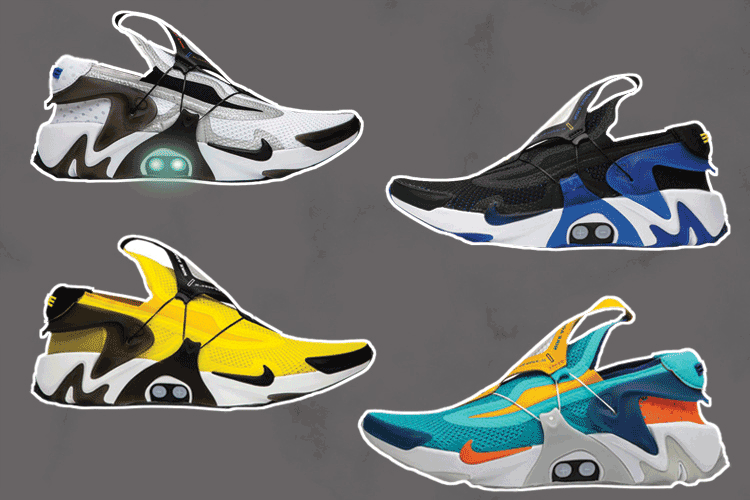Nike Adapt Huarache: Why is Self-Lacing Technology Only for High Fashion?
Graphic by Agnes Lee. Images via Goat
First released in late 2019, the Nike Adapt Huarache offers groundbreaking self-lacing technology with a sleek and futuristic design. These sneakers are the latest model using Nike’s FitAdapt technology and can be connected to a smartphone via the Nike Adapt App. With the touch of a button, users can remotely adjust the tightness of the electronic lacing system, which uses a midfoot motor.
Image via Nike News
The Adapt Huarache draws inspiration from the original 1991 Huarache with its neoprene, sock-like fit. The minimal silhouette serves as a backdrop to showcase the sneaker’s impressive adaptive lacing system, which is the real star of the show. The flashy lights don’t hurt either.
Additional tech features of the Adapt Huaraches include customizable colored lights, Siri and AppleWatch compatibility and wireless charging. Simply place the Adapt Huaraches on the charging mat and watch as the sneaker batteries fuel up!
Image via Nike News
This model highlights the remarkable advancement in intelligent technology and its seamless integration with sports design. The FitAdapt technology can ensure that athletes are able to focus on what they do best without any added distraction, like a shoelace malfunction. While the Adapt Huarache is catered more toward lifestyle wear, Nike also uses this self-lacing technology in the Adapt BB, a basketball shoe, and the 2016 HyperAdapt 1.0 for pro athletes.
Everyday tasks are now made much easier thanks to this adaptive technology. For people who struggle with restricted movement, tying shoelaces is not a simple, everyday task. It can especially pose a challenge as it requires bending down and fine motor movement, which not everyone can do without assistance.
Nike’s past efforts in adaptive footwear for the disabled community include the Nike FlyEase line, which uses adjustable straps instead of laces to tighten shoes and for easy entry. It was inspired by then-16-year-old Matthew Walzer, who has cerebral palsy. Walzer wrote to Nike in 2012 asking for a shoe designed for people like himself who experience difficulty tying traditional shoelaces. Nike designer Tobie Hatfield was already working on adaptive entry shoes for Special Olympians and Paralympians, and he developed a pair of basketball shoes with FlyEase technology for Walzer. It eventually expanded into the Nike FlyEase running and basketball shoe lines.
Image via Engadget
Self-lacing technology could be the next big step in adaptive footwear for people with disabilities that limit movement.
So, why is the Adapt Huarache marketed towards high fashion consumers rather than members of the disabled community who might benefit from this adaptive footwear?
Since the Adapt Huarache’s release in late 2019, there have not been any further updates on its technology or marketing efforts promoting this model to the disabled community. Though designer Hatfield commented on the potential of self-lacing technology in helping people with disabilities or conditions like Parkinson’s or arthritis, there has yet to be a self-lacing shoe model actively marketed as such. As the specific needs of a person with a disability will differ for each individual, adaptive footwear might require more intentional design and a focus on functionality than is currently offered by the Nike Adapt Huarache.
Some barriers to promoting the Adapt Huarache as a viable option could include its price and limited stock. The Adapt Huarache is retailed at $350, which is half the price of earlier non-commercial self-lacing models like the HyperAdapt 1.0, but is still a hefty investment for most consumers. As of February 2020, the resale price for most colorways are between $350-$450 on online marketplace StockX. The limited availability of the shoes also provides an obstacle for mass consumer use.
As a leader in sports footwear innovation, Nike has the responsibility of marketing and designing products in an inclusive manner. And as a company committed to “breaking down barriers for all athletes,” Nike should continue to innovate and find a way to integrate this self-lacing technology in a shoe model designed for the disabled community. Let’s celebrate all that the Nike Adapt Huarache has to offer, but also strive for more and look forward to what is to come.




